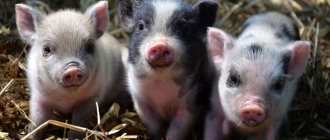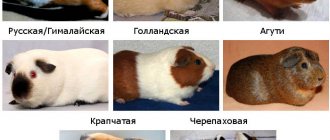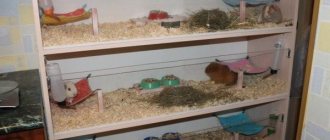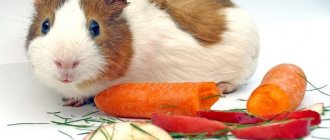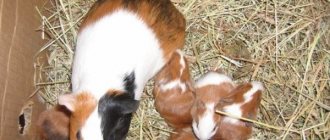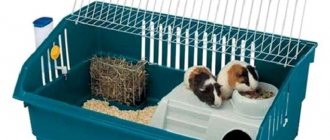A novice herdsman does not always understand why the pig does not eat, but lies. This situation cannot be ignored, because the appetite of livestock is one of the main indicators of its health. There are several reasons that cause this problem: from improper living conditions for animals and poor diet, to serious infectious diseases. Let's figure out what to do if the pig doesn't get up and refuses to eat.
Reasons for refusing to eat
A completely healthy pig has a good appetite. If the animal has become less active, constantly lies down and does not touch food, you need to look for a problem. Livestock may ignore feed completely or eat very little. Such a reaction most often indicates some kind of pathology in the pig’s body. The reason may be due to the following factors:
- avitaminosis;
- worms;
- infections;
- all kinds of diseases;
- improper care;
- stress.
Vitamin deficiency in pigs is most often caused by a lack of vitamin D, which appears due to an unbalanced diet and lack of essential microelements. Worms enter the body through water, unprocessed meat and soil. They cause bacterial and viral infections that cause intoxication. Also, the reasons for refusing food are stressful situations, poor quality care and maintenance, and loud noise from operating appliances. Below we will take a closer look at each of the reasons.
If a nursing pig refuses to eat, health problems may arise for her offspring.
Violations of containment conditions
Unsanitary conditions, gas pollution, dust, heat, high or low humidity lead to a deterioration in health and a decrease in feed consumption.
The effect of heat stress on pigs - low weight gain and poor productivity
To prevent pigs from losing their appetite, it is necessary to equip the room with ventilation and prevent slurry from getting into the feed.
For newborn piglets, the optimal ambient temperature is +25 ⁰С. After a week it can be reduced to +20 ⁰С. In winter, the temperature in the pigsty should not fall below +13 ⁰С and rise above +20 ⁰С. This mode can be maintained using lamps or heating devices. Additionally, a flooring is made, raised to a height of approximately 20 cm above the floor level and covered with straw. Comfortable humidity for a pig is 50-70%.
Exanthema vesicular
The piglet refuses food due to exanthema, an infectious pathology. The cause is calicivirus. The incubation period for the disease lasts from 12 hours to 2 weeks. During exanthema, the animal has a fever, and its body is covered with many rashes. Also, neoplasms appear on the mucous membranes of the mouth and snout. Inside the rash there is serous fluid.
The pig feels very weak, so he constantly lies down. After some time, the temperature of sick cattle drops, and the affected areas become covered with a yellow crust. Without proper treatment, the second stage of the disease begins, during which the rash covers the toes and hooves. The animal still does not eat and begins to limp. A sow gives birth to a dead piglet. The uncomplicated form of the disease lasts about 1-1.5 weeks, while the chronic form lasts 2-3 weeks.
Diseases
This is the most common reason for piglets refusing to eat. Their body acts in the same way as a human, so their appetite decreases or completely disappears. Diseases can be infectious (the most dangerous) and non-infectious.
Worms
When affected by infestations, the animal’s appetite does not always increase; most often it disappears against the background of a general deterioration in health. You can recognize a worm infestation by the following signs:
- increased anxiety;
- insomnia;
- rubbing the tail area against other objects (trying to scratch);
- sneezing, coughing, hoarse grunting - if the nasopharynx is affected;
- sudden weight loss;
- increased body temperature;
- hoarseness of voice.
Pigs do not always behave calmly; in rare cases they become aggressive, even to the point of attacking humans and biting.
Parasites can be found in feces. Antiparasitic drugs are used for treatment. The choice of a specific product depends on the age of the piglet and the type of helminths.
What you need to do:
- separate a sick pig from healthy individuals;
- carry out anthelmintic treatment of the remaining piglets;
- disinfect the pigsty, feeders, dishes, working tools, etc.
Edema disease
Most often it occurs immediately after weaning babies from the sow. Since the nervous system is affected, it manifests itself with specific symptoms:
- a sharp increase in body temperature;
- paralysis in the limbs;
- swelling of the eyes;
- swelling of the head and sternum area;
- loud squealing due to pain.
If you do not contact a veterinarian in a timely manner, the animal will die.
Plague
It is considered a deadly disease that rapidly spreads throughout the herd. The infection is transmitted not only through animals, but also through flies, insects, birds, rats, tools, and the owner’s clothes, therefore, when plague is detected, complete disinfection is carried out.
Piglets affected by the plague are destroyed.
The plague can be African and classical, and is not detected for 7 days. The causative agent is a togavirus that secretes ribonucleic acids that accumulate in the liver, bone marrow and blood vessels.
Within a short time, internal organs and systems are destroyed, causing the animal to die. How does it manifest itself, other than lack of appetite:
- increased body temperature;
- lethargy;
- vomit;
- the formation of purple-red spots in the head, ears, and thighs.
Smallpox
A viral pathology that is not transmitted to humans. After infection, the piglets' body temperature rises, formations are found on the mucous membranes and skin. Against this background, the animals become weak and completely refuse to eat.
To solve the problem, you need to contact a veterinarian who will prescribe special ointments and cauterizing solutions.
Erysipelas
Erysipelas is a disease identical to the plague, manifests itself with the same symptoms, and is dangerous. The difference is in the location of the violet-red spots - with erysipelas, they form on the soles of the hooves.
Unlike plague, piglets recover in 8-15 days.
Swine flu
The disease is not considered dangerous, since piglets do not die from it, but are difficult to tolerate, so it is important to use drugs aimed at eliminating symptoms and strengthening the immune system to alleviate the condition.
How it manifests itself:
- refusal to eat can be partial or complete;
- the piglet sneezes and coughs all the time;
- redness appears throughout the body;
- Mucus discharge flows from the nose and eyes.
The veterinarian will definitely prescribe antibacterial therapy.
Dysentery
The pathology is very dangerous for small piglets, as most often they die. Animals abruptly refuse food because their body temperature rises too much. Mandatory signs are diarrhea, drowsiness, weakness.
If urgent measures are not taken (antibacterial treatment), the piglets will die within 4-5 days.
foot and mouth disease
It is considered a serious disease with a very severe course, especially for young animals. In piglets, the skin and mucous membranes become inflamed and watery blisters form on them. For this reason, animals cannot eat food.
Treatment is relevant only in the first 2-3 days of infection, but most often the pigs die.
Rabies
This is a viral pathology that is dangerous not only for animals, but also for people, but only if a person is bitten by an infected piglet. The spread is rapid, the incubation period is from 3 to 8 weeks.
Symptoms manifest themselves as follows:
- complete refusal of food, as it is painful for the piglet to swallow;
- aggressiveness of the animal;
- increased salivation;
- unsteadiness of gait.
Death occurs about a week after the first signs appear. A harbinger of death is paralysis.
Aujeszky
Another name is pseudorabies, which is fatal for young animals. For adults, the disease is not dangerous, as it is easily treatable.
Symptoms:
- first the body temperature rises;
- then lethargy appears;
- then appetite gradually worsens;
- the piglet begins to sneeze occasionally and completely refuses to eat;
- At the last stage, convulsions appear.
To prevent the development of the disease, preventive vaccination is carried out.
Vesicular exanthema
The disease is characterized by skin rashes and increased body temperature. Incubation – from 12 hours to 14 days. It is especially difficult for young animals. Vesicular exanthema manifests itself in stages:
- Primary. The animal has a fever, so it cannot get up. At the same time, too much saliva is released from the mouth, which prevents him from eating food. During the same period, a rash forms in the area of the patch and lips. The rashes are yellowish and crusty. After their appearance, the temperature drops sharply.
- Secondary. Acne spreads to the hooves (the area of the corolla and between the toes). The pig completely refuses any food and begins to limp.
Only antibiotics are used for treatment.
Non-communicable pathologies
Among the non-dangerous diseases in which piglets do not eat anything are the following:
- Gastroenteritis. The pancreas and stomach are affected, so pigs experience severe pain, which is why they refuse to eat. Against this background, a sharp decrease in body weight occurs.
- Encephalomyelitis. The second name is Teschen's disease. The brain is affected, causing constipation, hyperthermia and convulsions. Most often, young animals cannot survive the disease.
- Salt poisoning. The main reason is too much salt in the diet. The main signs are that the animal is constantly thirsty, the temperature rises, and chills appear.
In all cases, it is recommended to immediately call a veterinarian and conduct a thorough examination to promptly identify dangerous pathological abnormalities.
Deadly Plague
If the pig does not eat because of the plague, immediate action must be taken. This is a highly contagious disease that affects the blood vessels.
Also, with severe plague, the gastrointestinal tract becomes inflamed and pulmonary pneumonia begins. The disease occurs in a feverish form. It is caused by a togavirus, which contains ribonucleic acid. It accumulates in the lymph, bone marrow, and affects blood vessels and the liver. The result is very deplorable: the walls of the blood vessels become thinner, hemorrhages begin, and the tissues die.
The incubation period of the plague extends to a maximum of a week. After this, the boar’s temperature rises sharply by 2 degrees, and hemorrhages appear near the ears, thighs and abdomen. Animals feel sick and vomit, they become lethargic and refuse to eat. They develop diarrhea and their stool contains blood clots.
At the moment there is no cure for plague, so the animal dies 2-3 days after the onset of the disease. In young livestock, the disease is more severe. Once the disease is confirmed, the animal is immediately slaughtered to prevent the spread of the pathology.
The effect of stress on the appetite of piglets
A number of factors have a depressing effect on the piglet’s nervous system:
- weaning piglets from the sow;
- change of location;
- transfer to another type of feed;
- carrying out vaccinations, operations, injections;
- insufficient lighting in the room;
- crowding of individuals;
- sudden changes in ambient temperature.
The most dangerous period in the life of piglets is weaning. The cubs are deprived not only of milk, but also of their mother, the opportunity to lean against her warm side if the room is cold. The piglets become depressed and stop eating.
To stimulate the appetite, animals are given special feed, however, not all farmers are aware of this need. How to get piglets to eat?
It is necessary to include in the feed mixture those flavoring additives that are present in the feed: milk powder, a mixture of organic acids, glucose or molasses, copper sulfate. To prevent feed stress, piglets are taught to eat solid food from the age of five days.
Babies are given delicious prestarter feed. If the farmer does not purchase compound feed, he can whet the kids’ appetite with roasted barley.
Be sure to read:
Erysipelas in pigs: description, forms and their symptoms, how to treat at home, serum, vaccine
Any processing of feed (forage) - extrusion, flattening, granulation modifies polysaccharides and stimulates appetite.
Drug prevention of stress - injection of drugs against iron deficiency anemia. Suiferrovit or similar preparations include B vitamins, organometallic salts of trace elements that have an anti-stress effect.
Enzootic pneumonia
Also, pigs do not eat because of pneumonia, during which the respiratory system suffers. The disease occurs due to a virus and most often affects young cattle under one month of age. The situation is complicated by the microbe's resistance to antibiotics, so it stays in the animal's body for a long time.
The incubation period lasts about 1.5-2 weeks, and the first symptoms appear after 3 weeks. The animal's temperature rises to 41 degrees or higher, and a dry cough and sneezing begins. If the disease is not treated, it can last for several months. Animals do not immediately refuse food. At first they continue to eat normally, but during feeding they begin to have a coughing fit. Then breathing quickens, the pigs feel depressed and stop eating, so they lose weight and height. With timely, proper treatment with antibiotics, the disease lasts 1-2 months.
Why do piglets eat poorly?
The piglet does not eat for several reasons:
- he was overtaken by an infectious disease;
- parasites in the intestines bother you;
- the food is tasteless.
The onset of infection can be judged by the increase in temperature, at which the piglets drink a lot, changes in skin color and behavior: the baby is breathing heavily, does not run, and is coughing. The presence of these signs is a reason to urgently call a veterinarian. He will most likely prescribe a course of antibiotics and maintenance vitamin therapy.
Worms and other parasites can enter the baby's body in the womb (if she did not receive medicine) or through dirty bedding or food. The presence of parasites is indicated by:
- diarrhea or constipation;
- general lethargy;
- cough without fever.
Children are given an anthelmintic with food.
Reluctance to eat the food offered may be due to its quality. A mash made from grain with signs of mold or from spoiled food waste causes disgust in the animal. Pigs will not eat food that is too cold, hot or salty.
When feeding dry formulas, it is important to ensure free access to water for the livestock. Thirst affects loss of appetite.
Dangerous swine flu
Cattle may ignore feed due to influenza. This is an infection that has an acute course. It occurs due to the influenza virus, which causes inflammation of the mucous membranes of the respiratory system. The infection can be diagnosed by testing blood, urine, or cough secretions. The incubation period for influenza is short. The first symptoms begin 2 days after infection.
Animals' temperature rises sharply, 2 degrees above normal. They lie almost all the time, do not react to extraneous noises and refuse to eat. The respiratory system suffers, resulting in coughing and sneezing. If there is no treatment, conjunctivitis begins. During the flu, the piglet rubs its head against walls and doors, and the tail, limbs and ears take on a bluish tint.
Signs of the disease disappear after a few days, but then appear with renewed vigor. In addition to the above symptoms, arthritis, inflammation of the lungs and maxillary sinuses begin. In severe cases, meningitis may develop. In this case, there is a high mortality rate of piglets. On average, 50% of the total number of sick livestock die.
Viral gastroenteritis
This is another disease that causes pigs to refuse to eat. It is characterized by an acute course. The disease is caused by RNA containing coronavirus. Because of it, a large number of young animals die. The virus does not tolerate ultraviolet rays, light and heat, and therefore dies under their influence. Moreover, in severe frost conditions the virus is active for at least 2.5 years. The virus accumulates in the intestines, after which it enters the bloodstream and spreads throughout the internal organs.
The latent form of the disease in newborn piglets lasts up to 12-18 hours, in young pigs - a maximum of 4 days, and in adult pigs - a week. Symptoms also depend on the age of the animal. In young animals they are as follows;
- severe diarrhea,
- unstable temperature;
- constant thirst.
Most sick piglets die within 3 days after the onset of the disease. The wild boar's temperature rises slightly, appetite decreases, and diarrhea continues. Adult cattle are more resistant to gastroenteritis. Typically, a maximum of 20% of the herd dies. The disease is contagious, so sick cattle must be isolated immediately. More details in the article “About transmissible gastroenteritis of pigs.”
Constipation and bloating
Pigs don't want to eat if they become constipated. It can occur on its own, or be one of the manifestations of another serious disease. In the latter case, the pigs feel weak, constantly lie down, breathe heavily, and their temperature rises. The problem arises if the diet is formulated incorrectly, too much food is fed or expired products are fed.
If the disease appears due to an improper diet, laxative medications are used. It is necessary to eliminate nutritional deficiencies and provide the animal with the necessary amount of clean drinking water. When the cause is serious illness, you should immediately contact a veterinarian.
Bloating occurs when there is a large amount of gases, increased gas formation and problems with their waste. The reason is using stale food and feeding large amounts of feed. Pigs behave restlessly and lose their appetite. They begin to salivate heavily, and the volume of their abdomen visually increases.
Stress
The nervous system of pigs is very sensitive, so external factors can have a negative impact, causing shock and stress. This condition, in turn, leads to decreased appetite and sudden weight loss.
What can scare a piglet:
- changing of the living place;
- change in diet (sharp);
- vaccination;
- the appearance of new animals in the pen, especially if they are not pigs (for example, cats, rats, chickens, kids, etc.);
- entering a pigsty of strangers;
- too bright or insufficient lighting;
- sudden changes in temperature.
Those individuals who are transferred from breastfeeding to full-fledged food are especially strongly affected by such factors, especially considering that the transfer itself is already stressful.
In this situation, to eliminate stress and improve appetite, various essential oils are added to the food (consult your veterinarian), and large areas for walking and playing are organized.
Vitamin D deficiency and poor diet
There is sometimes no appetite due to vitamin deficiency, which causes problems with phosphorus-calcium metabolism. This leads to rickets. At the onset of the disease, cattle exhibit perverted preferences. They refuse food, but begin to chew the bedding, manure, feeder, and lick the walls of the barn. The gait becomes mincing and limping. Animals fall while walking and squeal in pain. Symptoms also include bloating and lethargic behavior.
All those who are interested in pig farming must be able to organize livestock feeding. If you give a piglet very large, hot or cold food, it will begin to have intestinal problems. You also need to be careful with changing your diet. To avoid disruption of digestion, you need to gradually introduce new foods. Otherwise, diarrhea, constipation will begin and poisoning may occur. In this case, the pigs refuse to eat, lie constantly and are inactive.
Diagnosis of the problem
If a pig has lost its appetite and is not eating well, this is a reason to think about the state of its health. Many pathologies begin with the animal becoming bored and lethargic. The best solution is to call a veterinarian to determine the cause. When this is not possible, it is worth moving the piglet to a separate room and observing it.
If you experience diarrhea, cramps, increased body temperature, salivation or spots on the skin, you should contact a special service immediately. Losing time can lead to the death of the entire livestock of domestic animals.


